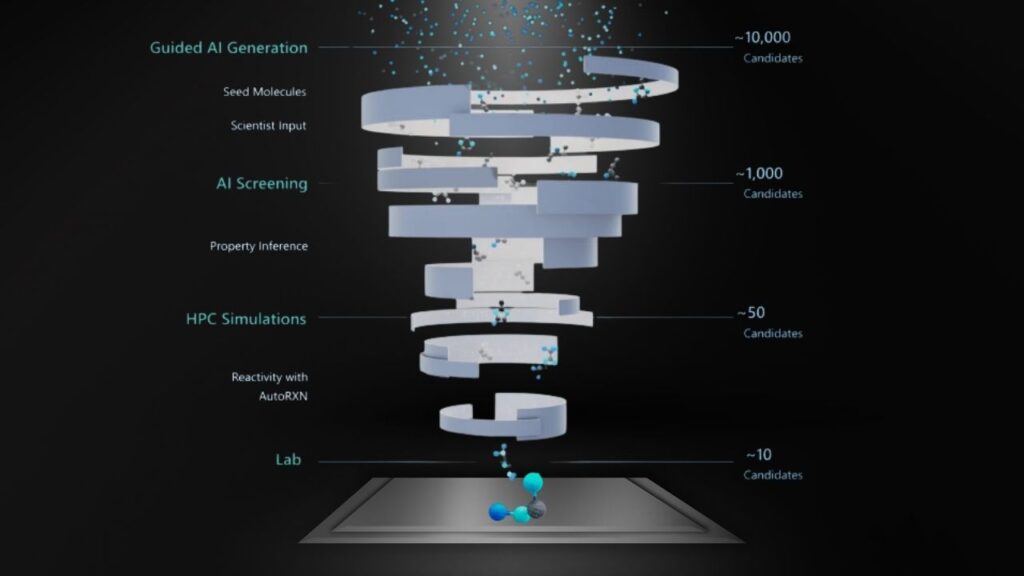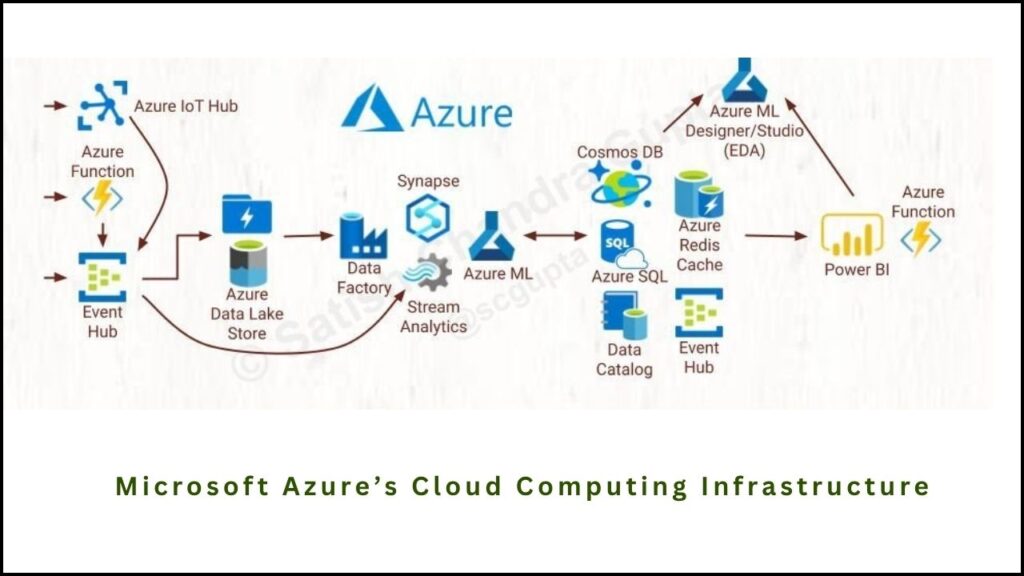Azure Quantum Elements for Material Discovery: Microsoft has officially launched Azure Quantum Elements, a groundbreaking platform designed to revolutionize material discovery by harnessing the combined power of artificial intelligence (AI), high-performance computing (HPC), and emerging quantum computing technologies. This innovative platform promises to accelerate scientific progress in chemistry and materials science by enabling researchers to explore vast numbers of potential materials at unprecedented speed and scale.

Material discovery is a cornerstone of many critical industries, ranging from energy and electronics to healthcare and manufacturing. The development of new materials can lead to improved batteries, more efficient catalysts, and novel pharmaceuticals. Traditionally, this process has been slow, expensive, and complex, often requiring years or decades of experimentation and computational modeling. Azure Quantum Elements offers a transformative approach by compressing what would take centuries of research into a fraction of the time.
This article provides a detailed yet accessible overview of Azure Quantum Elements. It explains how the platform works, its key capabilities, practical applications, and what it means for the future of materials science. Whether you are a student, a professional scientist, or an industry leader, this guide will help you understand the potential of this new technology.
Microsoft Launches Azure Quantum Elements for Material Discovery
| Feature | Description |
|---|---|
| AI + HPC Screening | Screens tens of millions of material candidates rapidly using AI-enhanced algorithms |
| Quantum-Ready Simulations | Hybrid classical and quantum computing workflows enable more precise simulations |
| Generative Chemistry | AI-driven design and generation of novel molecules with synthesis planning |
| Accelerated Density Functional Theory (DFT) | Faster and cloud-scaled DFT simulations to support material property prediction |
| Industry Collaboration | Partners include BASF, Unilever, Pacific Northwest National Laboratory, and others |
| Real-World Impact | Enabled discovery of novel battery electrolytes with 70 percent less lithium content |
| Official Website | Azure Quantum Elements |
Microsoft’s Azure Quantum Elements is a transformative platform that brings together AI, HPC, and quantum computing to vastly accelerate the discovery of new materials and molecules. By enabling rapid, large-scale simulations and generative design workflows, it addresses the key bottlenecks in materials research and development.
The platform’s proven success in battery electrolyte innovation, catalyst design, and partnerships with industry leaders underscores its potential to reshape multiple fields. For researchers and companies aiming to innovate faster and more sustainably, Azure Quantum Elements offers a powerful, accessible tool to unlock the future of material science.
Understanding Azure Quantum Elements: What Makes It Special?
At its core, Azure Quantum Elements is a cloud-native platform that allows researchers to explore and predict material properties through simulation instead of relying solely on time-consuming and costly laboratory experiments. The platform integrates three major computational approaches:
- Artificial Intelligence (AI): Machine learning models trained on vast datasets predict the properties of materials quickly and accurately.
- High-Performance Computing (HPC): Azure’s vast cloud infrastructure enables simulations and screenings at an industrial scale.
- Quantum Computing: Though still in early stages, quantum computing capabilities are integrated into the platform to enable simulations that are otherwise infeasible with classical computers alone.
This combination allows scientists to evaluate millions of candidate materials efficiently, accelerating discovery cycles significantly.
Why Accelerate Material Discovery?
Materials innovation is critical for addressing some of the world’s biggest challenges: clean energy, environmental sustainability, and technological advancement. For example, improving battery technology directly impacts electric vehicle adoption and renewable energy storage. Similarly, better catalysts can reduce industrial emissions and energy consumption.
According to data from Microsoft and its partners, Azure Quantum Elements can analyze approximately 30 million candidate materials in one week—a process that would traditionally require years or even decades of computational and experimental work. This is made possible through AI models that are 1,500 times faster than traditional density functional theory (DFT) simulations, which are widely used in material science to predict electronic structure and related properties.
These accelerated workflows enable industries to innovate faster, reduce costs, and develop more sustainable materials—ultimately benefiting society and the environment.
The Technology Behind Azure Quantum Elements

AI-Accelerated Screening
The AI models embedded in Azure Quantum Elements utilize graph neural networks (GNNs), which are particularly suited for chemistry and materials science. GNNs treat atoms as nodes and chemical bonds as edges in a graph, allowing the network to learn the complex spatial relationships and interactions within molecules or crystalline structures.
These AI models predict critical properties such as:
- Thermodynamic stability: Will the material remain stable under given conditions?
- Electronic properties: Band gap, conductivity, and other electrical characteristics.
- Mechanical strength: Elasticity and hardness relevant for structural applications.
Because these predictions are much faster than running full quantum mechanical simulations, researchers can rapidly narrow down the candidate pool to the most promising materials.
High-Performance Computing Power
Microsoft Azure’s cloud computing infrastructure underpins the platform’s scalability. HPC clusters in Azure can run thousands of simulations in parallel, a key factor that allows screening tens of millions of candidates within days.

The cloud-based nature also means research teams worldwide can collaborate without needing access to expensive supercomputers locally. This democratizes advanced materials discovery and opens the door for smaller companies and academic institutions to participate.
Quantum-Ready Hybrid Workflows
Quantum computing, though still nascent, promises to solve some material simulation problems exponentially faster than classical computers. Azure Quantum Elements includes a quantum-onramp—a feature that assesses whether a given problem might benefit from quantum computing.
Researchers can run hybrid simulations that combine classical HPC methods with quantum algorithms on actual quantum hardware previews. These quantum simulations have already demonstrated potential in complex catalyst design and other chemical systems, marking important early milestones for practical quantum advantage.
Generative Chemistry: Designing Molecules with AI
One of the newest features of Azure Quantum Elements is Generative Chemistry. Unlike screening known materials, generative chemistry involves creating new molecular structures from scratch using AI.
This workflow uses generative models that learn from chemical datasets and can propose novel molecules optimized for target properties such as:
- Synthesizability (can the molecule be made in a lab?)
- Stability under operating conditions
- Desired chemical or physical functions
Generative Chemistry reduces the need for trial-and-error by directing chemists toward molecules that are both innovative and practical to produce.
Accelerated Density Functional Theory (DFT)
Density Functional Theory is a powerful quantum mechanical modeling method used to investigate the electronic structure of molecules and solids. However, traditional DFT calculations are computationally expensive and slow, limiting their use for large-scale screenings.
Azure Quantum Elements includes accelerated DFT workflows that leverage cloud-scale parallelism and optimized algorithms, cutting down simulation time without compromising accuracy. This advancement allows researchers to validate AI predictions and generative chemistry outputs more effectively, improving overall discovery confidence.
Real-World Applications and Success Stories
Battery Electrolyte Discovery
A landmark project using Azure Quantum Elements screened over 32 million candidate materials for next-generation battery electrolytes. This collaboration between Microsoft and the Pacific Northwest National Laboratory (PNNL) resulted in identifying roughly 500,000 stable candidates.
Among these, a novel electrolyte was developed that contains 70 percent less lithium compared to conventional electrolytes, a crucial improvement considering lithium’s scarcity and environmental impact. This breakthrough highlights the platform’s potential to contribute to sustainable energy solutions.
Catalyst Development
Catalysts are essential for speeding up chemical reactions in industries ranging from plastics to pharmaceuticals. Azure Quantum Elements has been used to simulate catalytic reactions using hybrid classical-quantum workflows, enabling deeper understanding of reaction mechanisms and faster development of improved catalysts.
Who Is Using Azure Quantum Elements?
The platform is already making waves across industry and academia. Key partners include:
- BASF: A global leader in chemicals, using the platform for materials innovation.
- Unilever: Applying generative chemistry to develop new consumer products.
- Johnson Matthey: Advancing catalyst research with hybrid workflows.
- Pacific Northwest National Laboratory: Pioneering battery research with Microsoft’s platform.
These collaborations highlight Azure Quantum Elements’ versatility and impact across sectors.
Practical Guide to Using Azure Quantum Elements
If you’re interested in leveraging this platform, here’s a step-by-step overview of how to start:
Step 1: Set Clear Objectives
Define the properties or functionalities you want in your material. Are you searching for a battery electrolyte with high conductivity? A catalyst that works at lower temperatures? Clear goals help tailor AI models.
Step 2: Prepare Your Data
Upload molecular structures or input parameters. The platform can also generate candidates via AI if you want to explore unknown molecules.
Step 3: Run AI Screening
Use the AI models to predict material properties at scale. This step filters out less promising candidates quickly.
Step 4: Validate with Accelerated DFT
Confirm predictions by running accelerated density functional theory simulations to obtain quantum-level insights.
Step 5: Explore Quantum Simulations (Optional)
If your problem is quantum-ready, try hybrid quantum-classical simulations using Azure’s quantum hardware preview.
Step 6: Analyze and Iterate
Leverage Microsoft’s integrated tools, including the Copilot AI assistant, for natural-language queries and data analysis.
CareCloud to Present on AI Innovation at Maxim Group’s 2025 Virtual Tech Conference
Microsoft Cuts 300 More Jobs, Extending Largest Layoffs in Years
AI Linked To Fourfold Increase In Productivity Growth And 56% Wage Premium
FAQs About Azure Quantum Elements for Material Discovery
What industries can benefit most from Azure Quantum Elements?
Energy storage, pharmaceuticals, chemicals, materials manufacturing, and consumer goods are some key sectors that benefit from accelerated material discovery.
How does Azure Quantum Elements ensure accuracy in predictions?
The platform combines AI predictions with accelerated quantum mechanical simulations (like DFT) and uses real-world data to continually refine models.
Is there support available for new users?
Yes, Microsoft provides comprehensive documentation, tutorials, and customer support, including integration with Microsoft Copilot for interactive assistance.
Can smaller companies afford to use Azure Quantum Elements?
Azure Quantum Elements is cloud-based and scalable, allowing users to pay based on usage, which can be cost-effective for smaller organizations and research groups.






